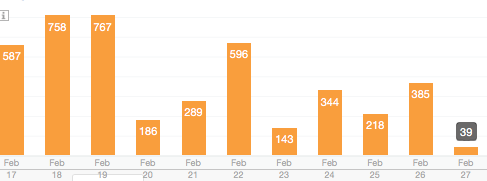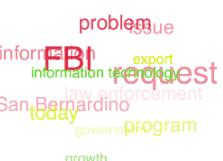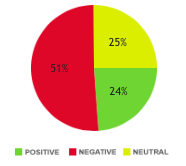Tell Better PR Stories with Data Visualization
There’s no denying it. “Storytelling” has become a public relations buzzword.
The concept is, of course, nothing new. Most of what PR pros do – from crafting campaign messaging to maintaining relationships with members of the press – is done out of a belief that compelling narratives influence the way people think. That said, the perceived value of stories has grown in recent years.
This isn’t a negative trend, but it raises a complex and difficult-to-answer question. In an age where we’re continuously flooded with digital information, what kinds of stories can actually grab – and hold – the public’s attention?
Looking at the data is one surefire way to find out. You can help clients tell better, more resonant stories by analyzing trends in news stories, features, and other media content related to their niches. This post will delve into the benefits of telling stories derived from media data, then describe how tools that turn this data into visuals can simplify the process.
It’s (still) all about the story
What, exactly, is a story? A sequence of events? A meaningful description of a human experience? A climax followed by a resolution? A more surprising – but no less true – answer is that stories are the lifeblood of public relations.
Those of us who communicate for a living know the value of using a narrative to bring facts to life. There’s now a growing body of scientific evidence to back us up; a number of recent studies have concluded that the human brain is actually hardwired to engage with stories.
According to Scientific American, the Wason selection task (a well-known logic puzzle that involves playing cards) is only understood by about 10% of people who attempt it – until it’s presented as a story. When the same puzzle is conveyed as a narrative about cheating and social rules, that number jumps to somewhere between 70 – 90%.
Our story-centric understanding of the world has significant implications in the marketing field. In a classroom study, Stanford School of Business professor Jennifer Aaker measured the retention rate of information conveyed in a set of short student marketing pitches. Aaker found that a mere 5% of those surveyed were able to recall a statistic from the pitches shortly after seeing them. In contrast, 63% were able to remember a story. Such conclusions confirm what successful public relations practitioners already know: a collection of facts – even a collection of surprising facts – is rarely memorable.
Unfortunately, when it comes to telling stories that get remembered, those in PR have it especially hard. Like marketers, PR practitioners struggle to convey brand values to an increasingly distracted public. This is, in and of itself, a daunting task. But practitioners in the field must also be adept at facing some of the harshest storytelling critics of all – journalists.
What does it take to tell a story compelling enough to capture the public’s imagination and pass the exacting standards of most journalists? In many cases, a fresh take on a tried-and-true topic is the answer – so long as you have the evidence to back up your point of view. Unfortunately, complete stories rarely drop into our laps. Finding the information you need can take some digging. To make things easier, ensure you’re looking in the right place.
Mining media data for stories
You’re probably already aware of the most important places to find brand-bolstering stories. They exist within the personal and professional histories of company founders, employees, and early investors. They’re unearthed during conversations with customers and users – people who have overcome obstacles through a relationship with the brand you represent. These people are the heroes of your stories.
But for initial inspiration, it often makes sense to look to the media. What’s happening in the spaces in which your clients operate? How are media outlets covering relevant events? Which topics and angles are dominating in the press, and where do potentially-interesting gaps exist?
Routinely skimming online magazines and useful sections of local and national newspapers can help PR practitioners answer these questions, which can lead to story ideas that capture the public’s imagination. More often than not, relevant media continues to shape these stories as they develop (by, for example, providing models and backing research).
Media insight is powerful. But at a time when mind-boggling quantities of content are published every minute, it can also be difficult to achieve. When reading through all relevant information is an impossibility, how can we begin to understand the big picture? Without a clear idea of what’s happening beneath the chaos, it’s hard to know which stories are ripe for conversation, which can be revived from a new angle, and which are straight-up over publicized.
Through effective media analysis, it’s possible to identify trends in large volumes of relevant content. Technology can help by turning news into data that can be broken down more easily. The right tools can process all of the media surrounding a specific industry, topic, or idea published during a given time period. Some communications professionals are already using data related to digital media to drive certain elements of strategy. For example, analyzing large volumes of information from Twitter can help determine the best times to publish certain types of content.
Far fewer practitioners are looking at media data for the purpose of shaping brand narratives, though the benefits of doing so can be significant.
Connecting the dots with visualization
Most of us aren’t data scientists; we’re unlikely to get much out of staring at a wall of statistics. But, like the old adage says, a picture’s worth a thousand words (or a thousand statistics, or a thousand articles – you get the idea).
Data visualization software generates visual representations of large quantities of information – information that can’t be understood all at once in its original formats. These visual representations have allowed executives across many different industries – including insurance, banking, and retail, to name a few – to spot insights they otherwise couldn’t have.
Any public relations practitioners looking to improve her storytelling game can also benefit from visualization. Insight is most likely to come from relevant, high-quality results, so media-monitoring software with a strong visual component is often the best way to go. Below, we list a few of the characteristics a truly insight-provoking visualization software should have, as well as some functions it should perform.
Intuitive:
An outlying statistic can never provide the same quick insight as a spike in a graph. And the less time it takes to understand that graph, the more likely you are to notice media shifts and events that can be used as a springboard for your next story.
Remember: informative visuals shouldn’t require explanation. They should be clear enough to provide an at-a-glance understanding of trends in the data they represent.
Historical and forward-looking:
At-a-glance understanding should extend to data from the last ten days as well as the last ten minutes.
The best monitoring and visualization software provides media analytics for a useful span of time (we think two weeks is ideal). Allowing these visuals to inform your writing will ensure you draw on up-to-the-minute ideas in to your client’s industry as well as those insights that only come in retrospective (for example, picking up on and writing about a meaningful pattern in recent media can provide a fresh story angle).
Extracts important topics:
If you think all of the benefits of analyzing large volumes of data come from discovering trends, think again. Analytics powered by sophisticated computer algorithms can actually extract significant topics in relevant news — and the results are often surprising.
At any given time, a handful of stories dominate the headlines. Many of the articles reporting these stories contain very similar information from the exact same sources. Those looking to get a broad overview of relevant subject matter often skim through a handful of articles, which can mean seeing just one media opinion.
Topic-extraction technology can highlight the unique coverage that often gets buried. It greatly increases the odds that you’ll find different perspectives on popular stories, or that you’ll extract stories that aren’t highly visible (though they are often part of the collective consciousness anyway). For this reason, topic-extraction technology is great for brainstorming.
Highlights both negative and positive trends:
Having a clear sense of the general sentiment that is being expressed by the media with regard not only to your clients but to other industry players and relevant trending topics can be useful in finding new potential narratives.
Here’s an example. When the Apple Watch was launched last year, a massive tide of reviews swept tech news websites. At Gnowit, we used our news-monitoring system to create a search for the term “Apple Watch”. Our aim was to get a big-picture view of the reviews.
For us, one thing that stood out was the negative sentiment associated with the word “notification” (it appeared in a word cloud, like the one pictured in the section above). Sure enough, we found a handful of reviews that criticized the watch’s notification system.
As a company that uses our own notification system, how do you think we capitalized on this story? We started by asking pertinent questions. How does our system offer a better experience than than offered by Apple? Whose idea had it been to develop our notifications in the way that we did, and what life event lead to the idea?
It’s interesting to consider the fact that we may never have found the few articles about notifications were it not for a system that provided visualizations related to sentiment.
The Uniqueness of Brand Stories
There are countless ways in which software that visualizes media data can help PR practitioners tell better stories. Seeing the big picture can spark ideas you may not have had otherwise.
But, at the end of the day, the stories you tell are only as interesting as the experiences of the people who lived them. Building internal relationships – the kind of relationships that lead to free and easy exchanges of ideas – should be priority number one. Just don’t be afraid to try new methods of developing story ideas.
Feature image courtesy of April Killingsworth




